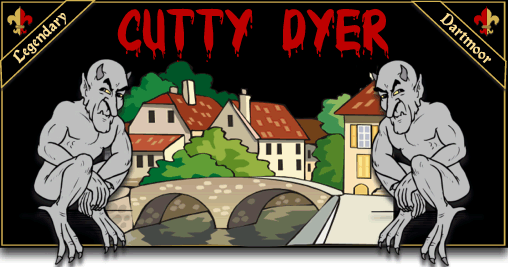
Now depending on who you ask, Cutty Dyer is either a water sprite or he is an Ogre. What is not in dispute is that he lives in the river Yeo or to call it by its modern name: the Ashburn, and that he is one thoroughly unpleasant person. Cutty has a penchant for luring naughty children, especially boys, to the banks of the Yeo and then dragging them into its icy waters where he would slit their throats and gorge himself on their warm blood. One of his favourite haunts was the King’s Bridge in the centre of Ashburton.
Adults were not above his attentions either, especially if they had stayed too long in one of the many pubs in Ashburton. As an illustration of what he was capable of, I will let William Crossing recount an encounter with Cutty Dyer:
“One night, when the hour in which Shakespeare tells us that “churchyards yawn” was fast approaching, two men might have been seen slowly making their way along the brink of the Yeo. Behind them the old town of Ashburton lay wrapped in slumber, and with the exception of the sound of their footsteps, and an occasional exclamation, the silence was unbroken. Had anyone been abroad at that late hour to notice them he would have seen that something seemed to hinder them from walking with that precision which is generally expected from people on the highway. It may have been that they were firm believers in the rule that there is no beauty in a straight line, but that a succession of curves was much more to be desired; or it is possible that the uncertain light of the moon rendered it difficult for them to see the road. It would also have been noticeable that they frequently stopped, and seemed to engage in an argument, one appearing to desire to go in a direction to which the other was altogether opposed.
In the midst of one of these discussions one of them suddenly started back and a loud yell rang out upon the night.
“Cutty Dyer!” he cried.
His companion grasped his arm and stared in the direction towards which he pointed.
There standing in the middle of the Yeo, was the gigantic form of the dreaded ogre. The water was dripping from his garments, and gleamed in the baleful light that shot from the great goggle-eyes of the monster. His black hair hung down over his shoulders in twisted locks that could only be likened to snakes, and his beard of the same colour descended to his belt. Little of his face was visible, but the huge yes, and the teeth like those of a shark, were quite sufficient to repress any inquisitive desire on the part of the men to see the rest of his features. Transfixed with horror, the two wayfarers stared wildly at those gleaming eyes. Slowly the monster raised his arm, and stretched out his hand towards them. Nearer and nearer it came, until the great fingers touched the shoulders of the nearest. Then the spell was broken, and with a cry of terror the men staggered away from the river.
Now at first sight Cutty Dyer’s conduct does not appear to be very commendable. But, we must know all the circumstances before we can judge in the matter. When we hear that on the following morning one of the wayfarers was found sound asleep in a cucumber frame, partially buried by the broken glass of the top light, and that the other was in the lock-up for having assaulted the constable, we shall perhaps be inclined to think that Cutty Dyer knew what was best for them when he offered to introduce them to his element.”
Pilkington, 1978, pp. 75-6, suggests a possible explanation for Cutty Dyer. He considers that ‘Cutty’ is an abbreviated form of St. Christopher and that in the middle ages there was an image of the saint near some stepping stones that went across the river Ashburn in Ashburton’s West Street. The churchwardens accounts for 1536 record that 6d was paid for “looking out stock to make St. Christopher.” In 1538 another entry shows that 9s was paid “in part of a greater sum for making image of St. Christopher.” Pilkington further postulates that this image was either used in a ‘miracle play’ or it was the one which stood by the stepping stones in West Street. Either way it was destroyed during the reformation and in those Puritan times the saint became an ogre with huge large eyes that were the size of saucers – or Cutty. But where did the ‘Dyer’ come from? The Oxford Dictionary defines dyer as meaning “a scoundrel of the deepest dye,”
Either St. Christopher or Cutty Dyer is reputed to be perpetuated in the name of Cuddyford Bridge which spans the Yeo.
Bibliography.
Pilkington, F. 1978 Ashburton the Dartmoor Town, Devon Books, Exeter.
 Legendary Dartmoor The many aspects past and present of Dartmoor
Legendary Dartmoor The many aspects past and present of Dartmoor

One comment
Pingback: 10 contos assustadores do folclore inglês - Replicario